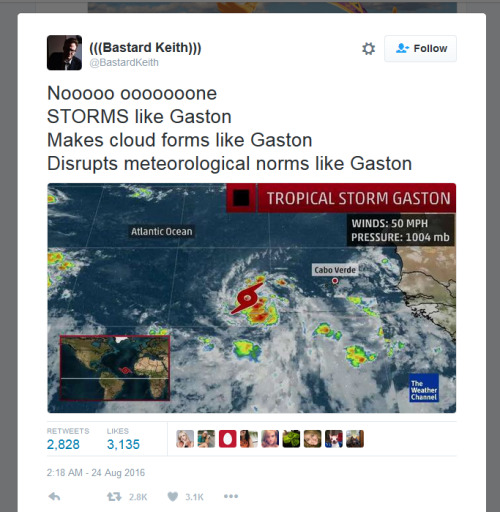Eugenics Was Massive In The US, However Much We Pretend It Wasn't
Eugenics was massive in the US, however much we pretend it wasn't
The U.S. Supreme Court in 1927 decided, by a vote of 8 to 1, to uphold a state’s right to forcibly sterilize a person who was deemed unfit to procreate. The case Buck v. Bell legitimized the eugenics movement – yes, the thing Hitler and the Nazis believed in – and directly led to the sterilizing of 70,000 American citizens against their will.
More Posts from Stubborn-turtle-blog and Others

Vulcanize-Charles Goodyear and the Roman god of Fire
The early nineteenth century saw tremendous advances in chemistry, with scientists leading teams all across the world to improve both science in general and industrial processes in particular. Leading the charge to improve rubber compounds was Charles Goodyear (born on this day, December 29, 1800, died July 1, 1860) who devoted his life and health to improving rubber compounds. Self taugh Goodyear ran a hardware store in Philadelphia and realized early that improved rubber goods would transform manufacturing.

He toyed with the chemistry of rubber manufacturing for two decades before hitting upon heating the rubber as the most important part of the process by accident. He was awarded a patent for vulcanizing rubber in 1844 for his efforts, though he still did not fully understand the process or what exactly was happening. Enduring backruptcy, jail, and personal tragedy, Goodyear died at the age of 59, collapsing at the news of his daughter’s death and never recovering.

The verb vulcanize was coined between 1820-1844 (several disputed dates are offered) to describe the process of changing something by adding heat or fire, from Vulcan, the Roman god of Fire. By 1846, the word was in wide circulation thanks to Goodyear’s patent. The company that bears his name today was actually founded almost 40 years after his death in honor of his contributions to the science of rubber compounds but also to capitalize on his fame and reputation. Etymologically, the name Vulcan (Volcānus or Vulcānus) has unclear origins. Some liguists connect the name with the Cretan god Velchanos, while others dispute this with no clear etymology. Vulcan’s earliest temple in Rome dates to 8th century BCE.
Image of vulcanization of rubber showing polymer bonds and portrait of Goodyear both in the public domain. Image of Vulcan at the Forge by Marco Dente (Italian, c. 1493 - 1527) in the public domain, via the National Gallery of Art, Washington, DC.
The wood siding could age badly unless it's well-treated, but otherwise cool.
I’ll be honest, my dream is to be a medical officer for a space company/organization







Seven Vehicles That Will Carry Humanity Into Orbit and Beyond Very Soon
The human race is quickly becoming a spacefaring civilization. During the Cold War, aggression and technological rivalry between two superpowers led to humanity’s first journey into space and to those first footsteps on the Moon. Today, exploration is driven by competition in the commercial space industry.
Private companies like SpaceX, Boeing, and Sierra Nevada Corp are already signed up to carry cargo to the International Space Station. Later, they’ll also build and fly their own human-capable spacecraft, while NASA itself focuses on building a vehicle that will eventually take humans to Mars. Read more about each spacecraft.
They are (from top to bottom):
1.) NASA’s Orion Spacecraft
First crewed launch 2021-2023
2.) SpaceX’s Crew Dragon
First crewed flight 2017
3.) Boeing’s CST-100 Starliner
First Crewed Flight: 2018
4.) Sierra Nevada’s Dream Chaser
First flight: 2019
5.) Blue Origin’s New Shepard
First Crewed Flight: 2018
6.) World View Capsule
First Crewed Launch: 2017
7.) Virgin Galactic’s SpaceShipTwo
Launch date: Unknown
Prepare for field research mayhem






Things I Learned as a Field Biologist #584
Going back to the field after a long hiatus can lead to moments of both visible excitement and stupefaction (with a slight register of anticipated grossness). Like my face, above. In South Africa. Where I will be once again in less than 48 hours! TO SEE ALL OF THE ANIMALS (but mostly the monkeys)!
Yes: after an absence of three long years, I leave for the field tomorrow!
This summer, I’m very excited to be returning to South Africa to work with vervet monkeys (Chlorocebus pygerythrus), using a number of methods to get at how they forage, what they eat, and ultimately how their bodies adapt to their nutritional environments in three places I’ve been before and loved working in: Soetdoring Nature Reserve, Gariep Dam, and Shamwari Game Reserve. Some of this work will involve live trapping and release, so to ensure to welfare and health of the monkeys I’ll be doing this work in collaboration with the wonderful Dr. Adrian Tordiffe of the University of Pretoria Faculty of Veterinary Sciences.
I’m also taking two of my BU undergrads with me for their very first field experience! Also making his South African and primatological fieldwork debut: my dad (in a supporting role: aka building monkey traps)! And, of course, my most wonderful postdoc, Maryjka Blaszczyk (this ain’t her first rodeo by a long shot).
AND THAT’S NOT ALL: I’ll also be teaching a group of students all about fieldwork and Primate Conservation Genetics in my field course with the prolific Dr. Trudy Turner of the University of Wisconsin in Milwaukee.
As you can see, it will be a packed summer, so I’ll be checking in more regularly to share all the new excitement (and yes, most likely a fair share of humorous mishaps and parasites) that a new field season in South Africa will bring. I’ll also be posting on Twitter and Instagram (@fuzzyatelin, #BUvervets16, #BlueScrotumSummer).
But as I hope you already know: I always save the juicy stories for right here…
This would have been so empowering for my ALS-stricken grandfather

Obi was built by Jon and Tom Dekar, the father-son duo that founded Obi parent company DESῙN in 2010. They spent the next six years refining Obi’s design, securing investors, sourcing suppliers, and testing prototypes. The first Obi prototype was designed in 2006 by Jon, a University of Dayton engineering student, who saw the challenges faced by people with disabilities as varied as his aging grandfather and a 6-year-old girl with Arthrogryposis.
“Every day, millions of people must be fed by caregivers, and they find the experience to be conspicuous and frustrating,” Jon said. “Feeding oneself is a basic human need, and there was no good solution available. I became inspired to change that.”
USADance (and I’m assuming the national organizations for other countries) still do this! The local chapters have to hold dances, and at least one of those a year has to be a formal: http://usadance.org/chapters/find-a-local-chapter/
You know what I wish we still had? Balls.
Like formal balls from fairytails. Instead of going to a club or a bar, you would go to a ballroom. There’d be music and dancing, and everyone could wear fancy clothes. There could be masquerades, where you could meet new people and reveal your real identity at the end of the night. There could be gay/lesbian balls and gothic balls and space fantasy balls. Just, formal balls.



Edgley Design builds family home around 100-year-old pear tree in south London »


-
 fortniteparadise liked this · 6 years ago
fortniteparadise liked this · 6 years ago -
 ragsreads liked this · 7 years ago
ragsreads liked this · 7 years ago -
 fuj-ju reblogged this · 8 years ago
fuj-ju reblogged this · 8 years ago -
 fuj-ju liked this · 8 years ago
fuj-ju liked this · 8 years ago -
 nerdygirlwithwings reblogged this · 8 years ago
nerdygirlwithwings reblogged this · 8 years ago -
 afloweroutofstone liked this · 8 years ago
afloweroutofstone liked this · 8 years ago -
 brokentowels liked this · 8 years ago
brokentowels liked this · 8 years ago -
 radlovedetective liked this · 8 years ago
radlovedetective liked this · 8 years ago -
 kale-amity reblogged this · 8 years ago
kale-amity reblogged this · 8 years ago -
 seavixxxen liked this · 8 years ago
seavixxxen liked this · 8 years ago -
 mayweneverrunout reblogged this · 8 years ago
mayweneverrunout reblogged this · 8 years ago -
 mayweneverrunout liked this · 8 years ago
mayweneverrunout liked this · 8 years ago -
 hansoline reblogged this · 8 years ago
hansoline reblogged this · 8 years ago -
 salirride reblogged this · 8 years ago
salirride reblogged this · 8 years ago -
 lunarosity reblogged this · 8 years ago
lunarosity reblogged this · 8 years ago -
 scarletstarletandthewanderthirst reblogged this · 8 years ago
scarletstarletandthewanderthirst reblogged this · 8 years ago -
 minervarosewilliams reblogged this · 8 years ago
minervarosewilliams reblogged this · 8 years ago -
 unoriginalcontent reblogged this · 8 years ago
unoriginalcontent reblogged this · 8 years ago -
 notsincetheincident reblogged this · 8 years ago
notsincetheincident reblogged this · 8 years ago -
 ebanashka liked this · 8 years ago
ebanashka liked this · 8 years ago -
 enbyalex liked this · 8 years ago
enbyalex liked this · 8 years ago -
 dani-cummings reblogged this · 8 years ago
dani-cummings reblogged this · 8 years ago -
 viridianequilibrium reblogged this · 8 years ago
viridianequilibrium reblogged this · 8 years ago -
 trufflupogus reblogged this · 8 years ago
trufflupogus reblogged this · 8 years ago -
 church-of-cherche reblogged this · 8 years ago
church-of-cherche reblogged this · 8 years ago -
 likelyslumbering reblogged this · 8 years ago
likelyslumbering reblogged this · 8 years ago -
 likelyslumbering liked this · 8 years ago
likelyslumbering liked this · 8 years ago -
 emotions-r-fr-th-weak liked this · 8 years ago
emotions-r-fr-th-weak liked this · 8 years ago -
 bonkboybusiness liked this · 8 years ago
bonkboybusiness liked this · 8 years ago -
 human-like-people reblogged this · 8 years ago
human-like-people reblogged this · 8 years ago -
 moss-sprouted liked this · 8 years ago
moss-sprouted liked this · 8 years ago -
 funeral-biscuit reblogged this · 8 years ago
funeral-biscuit reblogged this · 8 years ago -
 academicfeminist reblogged this · 8 years ago
academicfeminist reblogged this · 8 years ago -
 releventheeleventh liked this · 8 years ago
releventheeleventh liked this · 8 years ago -
 warmerkipferl reblogged this · 8 years ago
warmerkipferl reblogged this · 8 years ago -
 poltergeistings reblogged this · 8 years ago
poltergeistings reblogged this · 8 years ago -
 buddieboos liked this · 8 years ago
buddieboos liked this · 8 years ago -
 swagneato liked this · 8 years ago
swagneato liked this · 8 years ago -
 fairytalesandimaginings liked this · 8 years ago
fairytalesandimaginings liked this · 8 years ago -
 scarletstarletandthewanderthirst reblogged this · 8 years ago
scarletstarletandthewanderthirst reblogged this · 8 years ago
Gaming, Science, History, Feminism, and all other manners of geekery. Also a lot of dance
243 posts
